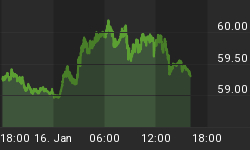As I step back to see the big picture of where the major economic forces are likely to drive our investments, I look to the big measures or our economy to see the forces that drive our future. The chart below will serve as a base line for discussion. It shows the trade deficit, the budget deficit and the value of the dollar all on one chart:

The chart shows how very big the trade deficit has become, and how the budget deficit of the Federal Government has switched from a modest surplus to a very big deficit. These two deficits are negative for the value of the US dollar. Looking at the purple line for the exchange value of the dollar, it was improving when the government deficit was improving, but has turned down now that the government deficit has gone very negative. The causes of the budget deficit are a slow economy, tax cuts, and the cost of war. The important message in these simultaneous negative movements of the twin deficits is that they move with the weakening dollar.
The visual impression is that the budget deficit has a closer relationship with the value of the dollar than the trade deficit. That is not always the case, but now the US has the unique position where the trade deficit effect has been muted by foreigners reinvesting their trade surpluses in the US, buying our Treasuries. The details of that foreign investment have been a theme that I have elaborated on in previous commentaries. Foreigners have purchased most of the US government debt as shown by the chart below.

Because foreigners used the dollars they obtained in trading with us to buy our government deficit, the effect of the trade deficit on the value of the dollar has been much smaller than it could have been.
We see that the dollar has dropped quite a bit recently. If the dollar drops, it is logical to expect that internationally traded benchmarks for world commodities might go up in purchase price, and the chart below shows one example. It compares oil and the dollar.

There are many drivers of oil beyond the value of the dollar, like world shortages, war, and growth in demand from China and India, but the pattern and opposite movement is obvious.
Here is the similar pattern for Gold:

Seeing these relationships play out, we now have a basis for how to predict the future for these related investments. If we can predict the government deficit, we have one important input for predicting the value of the dollar, and then if we know the direction for the dollar, we are in a better position to predict the price of important internationally traded goods, like oil and gold. There are many more inputs for predicting the individual resource prices, but this approach gives us a big picture underlying view of the overall environment. What we are really doing is not so much predicting the individual items like gold, oil or soybeans, we are predicting the value of the dollar.
So far these graphs only show that there is an important relationship, but that is not a prediction. We need to be able to predict the direction for the deficit, to have some idea about how the dollar and other resources will be priced. To get an idea of where the government budget deficit is headed, I present below one estimate for the spending and taxation. A precise forecast is impossible because all the components are continually changing, but there are plenty of reasons to worry that deficits will expand.

There are more negative views of what the deficit might become than the one above. Conversely, government officials are promising to do better. Government promises for iscal restraint do not have a good record. For example, if interest rate rise, requiring higher interest payments on the debt, or if world conflict escalates, requiring more military spending; the picture could become worse.
My conclusion is to expect future deficits to be expanding, especially in the longer term when Social Security and Medicare kick into high gear to cover the baby boom retirees, and to expect that this could expand deficits, decrease the purchasing power of the dollar and make resource prices rise. This is a parallel analysis to my other work and charts that interest rate could be rising. I am expecting a collection of related actions, including higher inflation, weaker dollar, higher interest rates, all to be a result of the expanding deficits. The higher interest rates will also have their own down stream impact on asset classes, like the housing bubble. My point here is not to be specific for particular investments, but more to give the rationale for the related movements of the overall system. I see a time more like our 1970s where inflation and commodities rose, while stocks were no higher at the end of the period, and were at a big loss in real purchasing power terms after inflation.
















